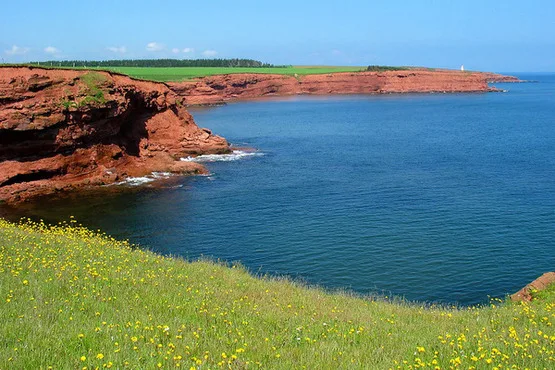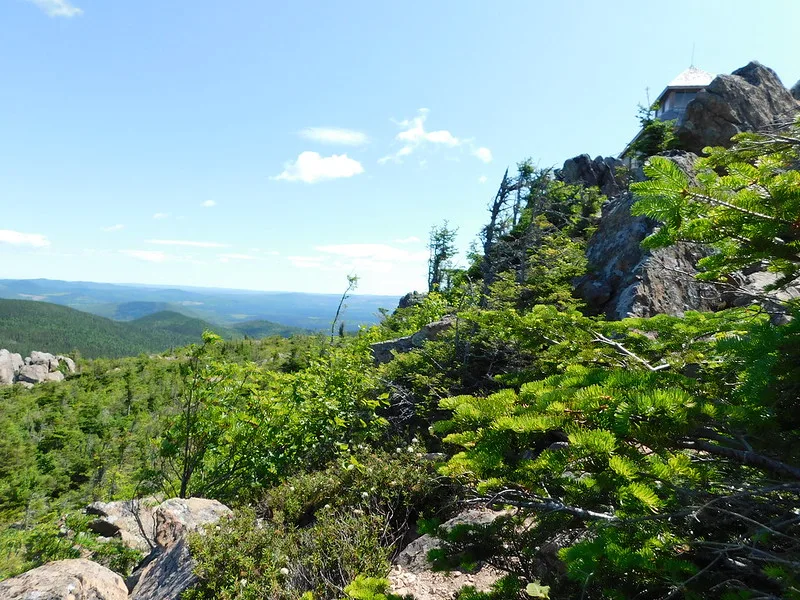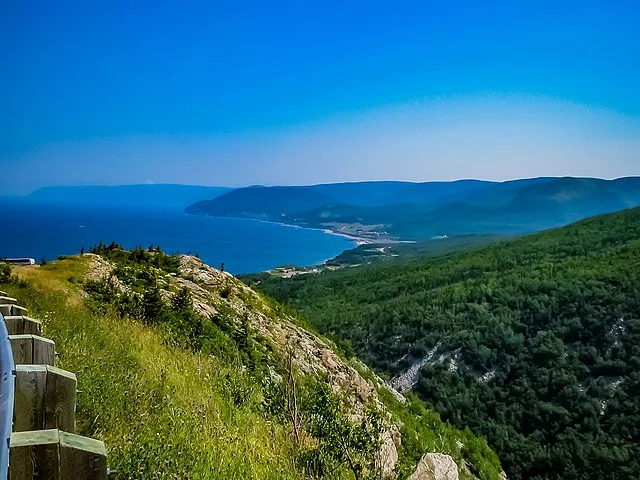The Summits of Canada Expedition began with the first climb on June 25, 2006. This time (May, 2012), the team carries their quest on over to the eastern boundaries & shores of Canada to the highpoints of the Maritimes. There wasn’t exactly a whole lot of what you would call “climbing” involved with this trip. But the incredible natural surroundings and culture that are distinctly unique to this area of Canada were definitely worth it. And, as usual, the team did manage to find a challenge or two to overcome as well as some unexpected surprises.
For lots more information and details about these unique Canadian highpoints, click below:
Exploring the Maritime Provinces
James and Len set out in mid-May for the highpoint of the three Maritime Provinces: New Brunswick, Prince Edward Island and Nova Scotia. Atlantic Canada provides visitors with a unique Canadian culture of friendly hospitality that is honed to near perfection over generations of people who have carved out niches among beautiful landscapes and multitudes of picturesque oceanic coves. Highpointing the Maritimes is about taking in what Atlantic Canada has to offer, setting time aside to smell the forests and the sea, and of course consuming a lobster … or two.

Author: Peter M Graham – flickr.com
Mount Carleton Adventure
The journey first took the boys to Mount Carleton in New Brunswick. Despite its relatively low elevation of 820 m (2,680 feet), they did manage to get into the clouds, as tradition would have it. After all, what’s a summit that doesn’t involve piercing the clouds? Doing a reconnaissance of the area the day prior to highpointing Mount Carleton paid off with finding a quick route that linked into the Park summit trail via a logging road that tapered into a nice short-cut trail. Moose, grouse, the odd black bear and, of course, white throated sparrows were featured residents.
The old fire tower that was utilized by the Forest Service until 1968 was close to the actual highpoint. This is definitely a hike worth taking, especially when one realizes and ponders the fact that 400 million years of mountain erosion have reduced the Appalachian mountains from Himalayan sized proportions to an altitude that is very manageable in a couple of hours of hiking. Mother Nature is a truly tireless worker!

Author : Jimmy Emerson, DVM – flickr.com
Highpointing PEI
Crazy as they are, as soon as they completed Mount Carleton, James and Len then decided to drive directly to PEI, and were able to highpoint this beautiful island the same day on May 14. This trip also included another lesson in how bad the placement of villages can be on Google Earth. Do not depend on Google Earth for locations of towns or villages as reference points; just use the imagery. High-pointing on PEI’s potato field (142 m, 466 feet) is one thing, driving over Confederation Bridge which spans 13 km of ocean to get to PEI is another! This internationally famous Canadian bridge really is amazing. Most of the curved bridge is 40 metres (131 ft) above water, and it contains a 60 m (197 ft) high navigation span to permit ship traffic.
A resident potato farmer informed us that a number of islanders still take the ferry instead of the bridge. This can involve substantially more driving time to get to the ferry (plus time on the ferry) than simply driving over the Confederation Bridge. Why do they do this? He mentioned it’s because of their fear of heights. If you spent a lot of time residing on PEI, you could see that such a perspective is possible given the island’s low profile; regardless, the ferry crossing is also a must for either coming or going just for the added experience of the crossing.
After summiting two peaks in one day, the evening was spent sleeping on the dunes of the north beach of PEI and being entertained by spring peepers (frogs) … of which was definitely the highlight for James; he loved the playback feature on Len’s tape recorder so that it would be twice as deafening! But where were James’ earplugs for Len’s snoring when he needed them?
As a bonus, we include here a sample of what these noisy lil critters actually sound like. This recording is only 47 seconds long, but … hmmmm, it’s difficult to imagine James & Len actually got any sleep this night considering how much louder this must have been in person and considering how long this “chorus of frogs” probably went on for.
White Hill Expedition
The third summit of this trip was White Hill of Cape Breton Highlands, Nova Scotia via the Lake of Islands trail (old fire road). The weather could not have been better and the snow had disappeared from the highlands. This is a trek that should be taken when the black flies are not in force, unless you truly are a masochist, so our timing was good. The mud holes that can pull your boots off are a bonus feature (not), along with an abundance of more moose antler drops. The bulls grow a new set of antlers every year, just to impress one another and, of course, the opposite sex.

Author : Michel Rathwell – wikimedia.org
Encounter with Wildlife
If it wasn’t for the old fire roads, getting to White Hill through an unbelievable never-ending entanglement of small, densely packed spruce trees would be an undertaking that would have to span a week (if one was lucky) rather than a full day trek one way. Along the way, we were wondering why most of the cow moose were heading in the direction of White Hill; would calving season have something to do with it? If so, caution would be in order. Len recalled having narrowly survived life threatening storms and plummeting, bone-chilling temperatures, and having avoided being taken out by avalanches and dangerous falling glacial seracs while on previous expeditions in the pursuit of the summits of Canada.
But this time we almost bit it a mere couple hundred meters from the top of White Hill when we suddenly came across and startled a cow moose that had just given birth to two twin moose, the next generaton of highpointers. Now that would have been a truly Canadian way of meeting our creator. Fortunately, Mama Moose remained still despite all indications of a potential charge as we cautiously retraced our steps and circled around to carry on with our quest. And as such, the Royal Canadian Geographic Society flag was once again raised on May 16 atop White Hill, with a perfect breeze to keep it aloft. It was then twenty-two kilometers back to the vehicle with another overnight bivy thrown in for good measure, and completion of the Cabot trail with a hearty lobster feast waiting in Cheticamp.
Reflections and Unity
Back in Cheticamp, we recalled the fun & adventures from this trip, and while easy in terms of actual “highpoint” climbing required, it was not without its challenges. We also started looking forward to a few of the remaining peaks yet to be experienced on our journey to bring this great country’s peaks and its natural settings and cultures to Canadians and the world. At this point, we asked the waitress serving us clam chowder and lobster dishes, “What unites us as Canadians despite the extent and diversity of our country”. Her reply was thoughtful and quick, “It’s because we’re friendly and we tolerate people that span this nation of ours”. She’s right of course. And what more can we say except: Oh Canada!? 🙂
Outdoor Travel Safety in Coastal Provinces
Exploring the stunning landscapes of the Maritime Provinces offers unforgettable experiences, but it’s crucial to prioritize safety while venturing into nature’s embrace.
Wildlife Awareness
The Maritime Provinces boast diverse wildlife, including moose, bears, and coyotes. To minimize the risk of encounters:
- Stay vigilant and make noise while hiking to avoid startling animals.
- Maintain a safe distance from wildlife and refrain from approaching or feeding them.
- Securely store food to prevent attracting animals to your campsite.
- Learn to identify signs of wildlife activity and adjust your behavior accordingly.
Weather Preparedness
The weather in the Maritime Provinces can be unpredictable, so it’s essential to be prepared for changing conditions:
- Check weather forecasts before your journey and be aware of potential hazards such as storms or extreme temperatures.
- Dress in layers to stay warm and dry, and carry extra clothing for unexpected weather changes.
- Stay hydrated and shield yourself from sunburn by wearing sunscreen and a hat.
- Exercise caution on slippery surfaces, particularly during rainy or snowy weather.
Emergency Preparedness
Being equipped with an emergency plan is essential for outdoor safety. Here’s what you should do:
- Share your itinerary with a trusted individual and check in with them regularly.
- Carry a fully charged cell phone or satellite communication device for emergencies.
- Familiarize yourself with the location of nearby emergency services and how to contact them.
- Carry a basic first aid kit and understand how to administer first aid for common injuries.
- Maintain composure and assess the situation calmly if an emergency arises, prioritizing safety above all else.
By adhering to these safety guidelines and staying informed about potential risks, you can embark on outdoor adventures in the Maritime Provinces confidently and responsibly, creating cherished memories while ensuring your well-being.
Conclusion
When exploring the Maritime Provinces, keep wildlife safety in mind. Make noise while hiking to avoid startling animals, maintain a respectful distance, and properly store food to prevent unwanted encounters. The weather in the Maritime Provinces can be unpredictable. Stay informed about forecasts, dress appropriately in layers, and take precautions against sunburn and slippery surfaces to ensure a comfortable and safe journey. Prepare for the unexpected by sharing your itinerary with someone reliable, carrying communication devices, and knowing how to access emergency services. Keep a first aid kit handy and remain calm in crisis situations. Above all, prioritize safety during outdoor excursions. By following these insights, you can embark on adventures in the Maritime Provinces with confidence, creating lasting memories while safeguarding your well-being.
FAQs
What precautions should I take to avoid encounters with wildlife in the Maritime Provinces?
In the Maritime Provinces, diverse wildlife like moose, bears, and coyotes roam the landscapes. To minimize the risk of encounters, it’s essential to remain vigilant, make noise while hiking, and keep a safe distance from wildlife. Additionally, securely store food to prevent attracting animals to your campsite and learn to identify signs of wildlife activity.
How can I prepare for the unpredictable weather in the Maritime Provinces?
The weather in the Maritime Provinces can be unpredictable, so it’s crucial to be prepared for changing conditions. Before your journey, check weather forecasts and be aware of potential hazards such as storms or extreme temperatures. Dressing in layers, carrying extra clothing for unexpected weather changes, and protecting yourself from sunburn with sunscreen and a hat are important precautions to take.
What emergency measures should I have in place while exploring the Maritime Provinces?
When exploring the Maritime Provinces, it’s vital to have an emergency plan in place. Share your itinerary with a trusted individual and check in with them regularly. Carry communication devices like a fully charged cell phone or satellite communication device, and familiarize yourself with the location of nearby emergency services. Additionally, carry a basic first aid kit and know how to administer first aid for common injuries.
How can I minimize the risk of wildlife encounters while camping in the Maritime Provinces?
To minimize the risk of wildlife encounters while camping in the Maritime Provinces, take several precautions. Securely store food to prevent attracting animals to your campsite, and make sure to dispose of waste properly.